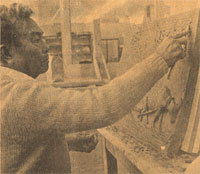Vietnamese Sculpture Luong Picks Up Pieces of Career
Photos and story, by Chris Olson
Grand Island Nebraska, Daily Independent
Saturday, October 25, 1975





|
|
Luong Van Dinh, 75, did not leave his native country by choice. Born on Vietnam on 1900, Van Dinh escaped with his wife, Mui Thi Tran, and three of his youngest children last spring when the Viet Cong took over South Vietnam.
It was not a pleasant departure. In leaving, he exchanges 75 years of love and respect for his countrymen, for life in a new land.
He left behind nine of his older children and all but four of his more than 50 grandchildren, in fleeing Saigon with 10 members of his family.
Van Dinh speaks no English and relies upon his son-in-law to interpret everything he says and hears. He communicates, however, through the universal expression of his art.
Although displaces from his country, Van Dinh is beginning to pick up the pieces of his career as one of Vietnamís most respected sculptors.
After 60 years of sculpting, his eyes are not weak, but his fingers still steady, as he molds and shapes clay with the skill of a master.
He had become an apprentice sculptor in Vietnam at the age of 16. After finishing his apprenticeship Van Dinh had moved to Hanoi, where he began accepting commissions for his sculpture.
Working primarily in bronze, cement, stone and plaster, Van Dinh had spent his life producing sculpture with religious, political and sociological overtones.
As a well-known sculptor in Vietnam, his political leanings had forces him to flee his home in 1954, when communist infiltration took over North Vietnam.
Setting up his studio in Saigon, however, he apprenticed his son Hai, to assist him in his workand began accepting commissions to produce sculptures for the South Vietnamese government.
At the height of his career, Van Dinhís works ranged from portrait busts to an outdoor, 30-foot sculpture to a series of religious sculptures, depicting the 14 Stations of the Cross.
Then he was forced to flee Saigon because of his association with the South Vietnamese government, Van Dinh had established a studio employing 10 workers.
Although most popularity known for his religious sculpture in China, Japan, Thailand and Vietnam, Van Dinhís works also portrayed Vietnamese political and sociological struggles.
Where his political leanings made him and immediate target of the North Vietnamese government, the religious faith that produced his more popular works sustained him whom he was uprooted from his country.
With the aid of his son-in-law, Tho Van Trinh, who was in the South Vietnamese Navy, Van Dinh and his family were able to escape Saigon on a 15-day journey via Guam and the Philippines, arriving at Camp Pendleton, Calif., on May 28.
On Sept. 26 he and his family arrived in Grand Island, under the sponsorship of St. Maryís Catholic Church. Today he lives at 1016 W. Second St. with his family, where he keeps the few small sculptures he was able to bring with him.
His works were recently discovered by the Central Catholic Artist-In-Residence program and currently Van Dinh has set up a temporary studio at the Central Catholic to conduct a two-week seminar on the art of sculpting in clay.
His mode of communication is essentially visual, as students study the sweeping movement of his fingers, as the skillfully attack a mound of clay and transform it into a work of art.
Using a flat-edge knife and a few simple tools, Van Dinh gouges and pokes at his clay, which gradually the clay responds, and the rough features of a face begin to emerge.
Absorbed in his work, Van Dinh appears to tune-out peripheral distractions and concentrates his mental and physical energies on a distant image of his completed work.
His major works in Grand Island so far consist of a small religious statuary and a relief sculpture of a Vietnamese farmer behind an ox in the fields.
His sculpturing exhibit a classic, social realistic style, with a general theme of his flight from Vietnam. His works in this country have been done primarily in clay.
As he works silently, manipulating the clay with his fingers, Van Dinh is no longer the displaced Vietnamese refugee, but the master at his work.
|
|